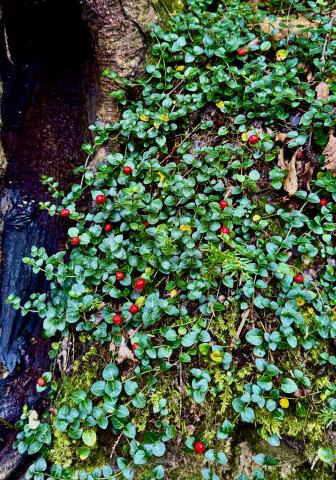Have Seeds Will Travel

This Partridge Berry is one of many plants that entice an animal to eat it as a means to spread the seed away from the mother plant.
By Steve Roark
Volunteer, Cumberland Gap National Park
Plant life is absolutely lush in our part of the world. If ground is not paved or has a building on it, it usually has plants growing on it or at least trying to get a toe hold. Which begs the question: how do plants spread if they are literally rooted to the ground? The answer is in seed design, and several ingenious mechanisms are used to allow plant embryos (seeds) to move away from the shadows of the mother plant.
Seed dispersal can be roughly divided into several broad categories: wind, animal, propelled, and dropped. Wind is known to all who have picked up a mature dandelion seed head and blew on it to watch the little parachutes (each with a seed passenger) float off on the wind. There are lots of plants that use wind for seed transportation. Milkweeds and thistle also use the parachute technique, and several use a single wing that spins around like a helicopter, used by maples, yellow poplar and ash. There are many other wind-borne seeds around.
Animal transported seeds fall into two categories: the clinging types are the sticky ones that attach themselves to fur or clothing. Many of you have cursed seeds like beggar lice, stick-tights, seed ticks, cocklebur, and others that cover your pant legs when walking in weedy places. The other animal transport mechanism is bribery. The plant produces a tasty fruit to entice an animal to eat it. The enclosed seed passes through the gut unharmed and is pooped out somewhere away from the mother plant with fertilizer to boot.
Propelled is where the seed has a mechanism that physically throws it away from the mother plant. Touch-me-nots are a good example, having seed pods that are spring loaded, and when mature will explode and throw the seeds all over the place. Witch-hazel, wisteria, and winter-cress all use this method.
I’ve seen gravity listed as a seed transport mechanism, and heavy round seeds like acorns, hickory nuts, and walnuts could drop off the tree and roll down the hill. But with most of our nut seeds, another animal transporter more likely comes into play. The squirrel, and to some extent bluejays, eating many nuts but also stockpile them for winter use, hiding them in the ground in various places. Thankfully they don’t remember them all and some get to sprout and grow a new tree some distance away from the mother tree.
Observe seeds out in the wild and see if you can figure out the transportation method it uses. They are further proof that nature does all things with a purpose.
- Log in to post comments